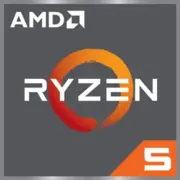AMD Ryzen 5 PRO 6650H

AMD Ryzen 5 PRO 6650H: Power and Efficiency for Mobile Tasks
(March 2025)
Architecture and Process: Rembrandt on 6 nm
The AMD Ryzen 5 PRO 6650H is part of the mobile solution lineup based on the Zen 3+ architecture (codename Rembrandt). It is produced using TSMC's 6-nanometer FinFET process, providing a balance between performance and energy efficiency.
- Cores and Threads: 6 cores, 12 threads — an optimal configuration for multitasking. Base frequency — 3.3 GHz, maximum in turbo mode — up to 4.5 GHz.
- Cache: 16 MB of L3 cache accelerates data processing, reducing latency when working with "heavy" applications.
- Integrated Graphics: Radeon 660M with 6 compute units (384 stream processors) and a frequency of up to 1.9 GHz. This is one of the most powerful integrated GPUs in its class, supporting DirectX 12 and HDMI 2.1.
The Zen 3+ architecture improves upon energy consumption optimization and increases IPC (instructions per cycle) by 5–7% compared to Zen 3. This is particularly noticeable in single-threaded tasks, such as office applications or web surfing.
Power Consumption and TDP: 45 W for Balance
The processor's TDP is 45 W, which is typical for high-performance processors in thin workstations and mid-range gaming laptops.
- Operating Modes: AMD provides flexible TDP settings. For example, in ultrabooks, manufacturers may limit it to 35 W to reduce heat, while in gaming models it can be increased to 54 W for stable turbo mode.
- Heat Dissipation: Thanks to the 6-nm process, the chip runs cooler than competitors based on Intel's 7 (10 nm Enhanced). However, high-quality cooling systems with dual fans and heat pipes are still required for maximum performance.
Performance: From Office to Gaming
Geekbench 6 test results (1798 points in single-threaded and 7318 in multi-threaded modes) place the Ryzen 5 PRO 6650H on par with the Intel Core i5-1340P and Apple M2 (8-core version).
- Office Tasks: In Microsoft Office, browsers with 20+ tabs, and apps like Zoom, the processor runs with virtually no load. For example, rendering a 30-minute video in DaVinci Resolve takes about 12 minutes.
- Gaming: The Radeon 660M handles AAA titles at low settings. For instance, in Cyberpunk 2077 at 1080p with FSR 2.1, it achieves 35–40 FPS. In CS2 or Dota 2, it maintains a stable 60–70 FPS.
- Turbo Mode: Under load, core frequencies stay around 4.2–4.3 GHz for about 20–30 seconds, after which they drop to 3.8–4.0 GHz due to heat. In laptops with effective cooling (e.g., Lenovo ThinkBook 16p), the drop is less noticeable.
Usage Scenarios: Who is the Ryzen 5 PRO 6650H Suitable For?
1. Remote Workers and Students: Multitasking (video conferences + document work + streaming) without lags.
2. Creative Professionals: Photo editing in Lightroom, 1080p video editing.
3. Casual Gamers: Gaming at medium settings or streaming via GeForce Now/Xbox Cloud.
4. Engineers: Code compilation, working in CAD applications (AutoCAD, SolidWorks).
Battery Life: How Long Will the Battery Last?
At 45 W TDP, the runtime varies by scenario:
- Web Browsing: Up to 8–9 hours (at a screen brightness of 150 nits and with "Power Saving" mode activated in Windows).
- Gaming: No more than 1.5–2 hours.
Power-saving technologies:
- Precision Boost 2: Dynamically adjusts frequencies to avoid excess heating.
- AMD PowerNow!: Disables unused cores in the background.
Comparison with Competitors
- AMD Ryzen 5 6600H: Without the "PRO" suffix, it is worse optimized for corporate tasks (e.g., data encryption).
- Intel Core i5-1340P: Comparable in multi-threading but lags in energy efficiency. In gaming, Radeon 660M is 15–20% faster than Iris Xe.
- Apple M2: Better in battery life (up to 12–14 hours) but weaker in multi-threaded tasks and gaming.
- Previous Generations: Ryzen 5 5600H (Zen 3) is 18% behind in single-threaded tests.
Pros and Cons
Strengths:
- High performance in multi-threaded tasks.
- Powerful integrated graphics.
- Support for DDR5-4800 and PCIe 4.0.
Weaknesses:
- Heating during extended loads.
- Limited number of laptop models with this processor (more often found in business lines from HP, Lenovo).
Laptop Selection Recommendations
- Type of Device:
- Ultrabook: ASUS ZenBook 14X (price from $999) — lightweight body, 2.8K display.
- Gaming: Acer Nitro 5 (from $1099) — discrete NVIDIA RTX 3050 graphics + good cooling.
- Workstation: Lenovo ThinkPad P15s (from $1299) — ECC memory support, rugged design.
- What to Look For:
- Cooling system (at least 2 fans).
- RAM: 16+ GB DDR5.
- Display: IPS panel with 100% sRGB coverage for creative tasks.
Final Conclusion
The AMD Ryzen 5 PRO 6650H is an ideal choice for those needing a versatile laptop with performance to spare for 3–4 years. It is suitable for:
- Freelancers — for working in resource-intensive applications.
- Students — a balance between battery life and power.
- Budget Gamers — capability to play without a discrete graphics card.
Key advantages include the energy efficiency of the 6-nm process, powerful integrated GPU, and support for modern standards (DDR5, PCIe 4.0). If you are looking for a laptop under $1200, this processor should be a top consideration.
Basic
CPU Specifications
Memory Specifications
GPU Specifications
Miscellaneous
Benchmarks
Compared to Other CPU
Share in social media
Or Link To Us
<a href="https://cputronic.com/en/cpu/amd-ryzen-5-pro-6650h" target="_blank">AMD Ryzen 5 PRO 6650H</a>